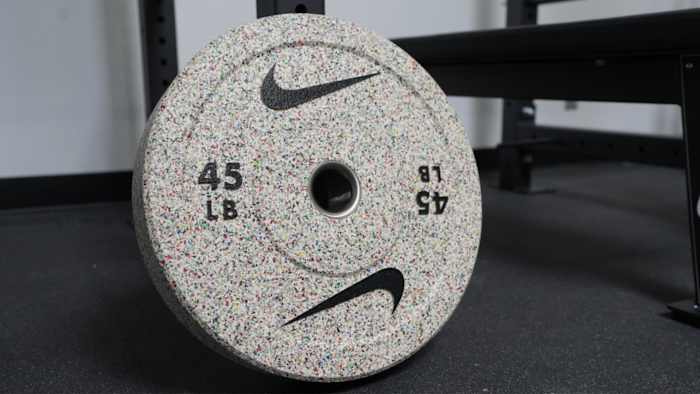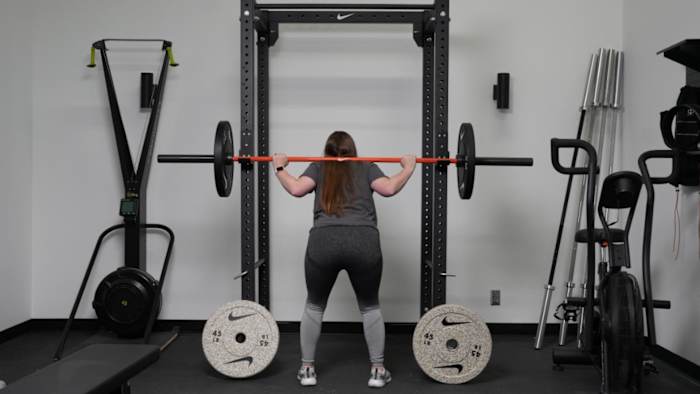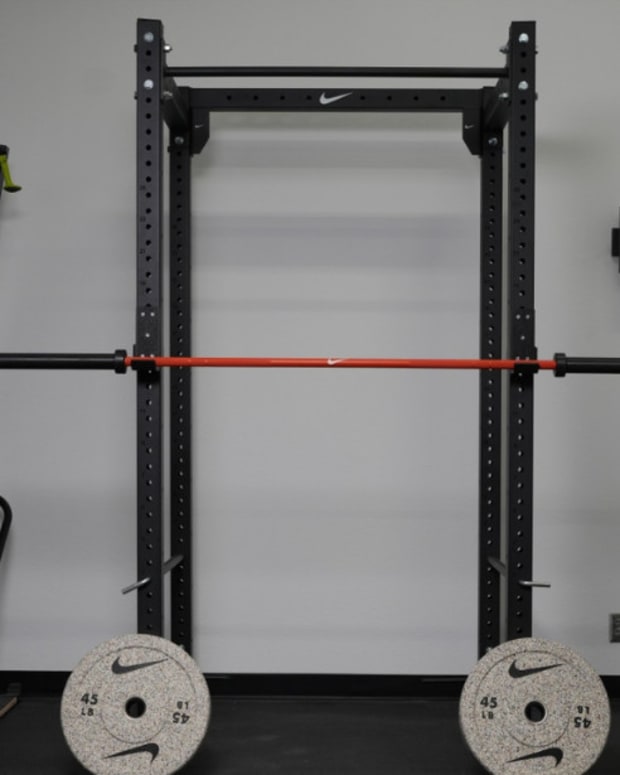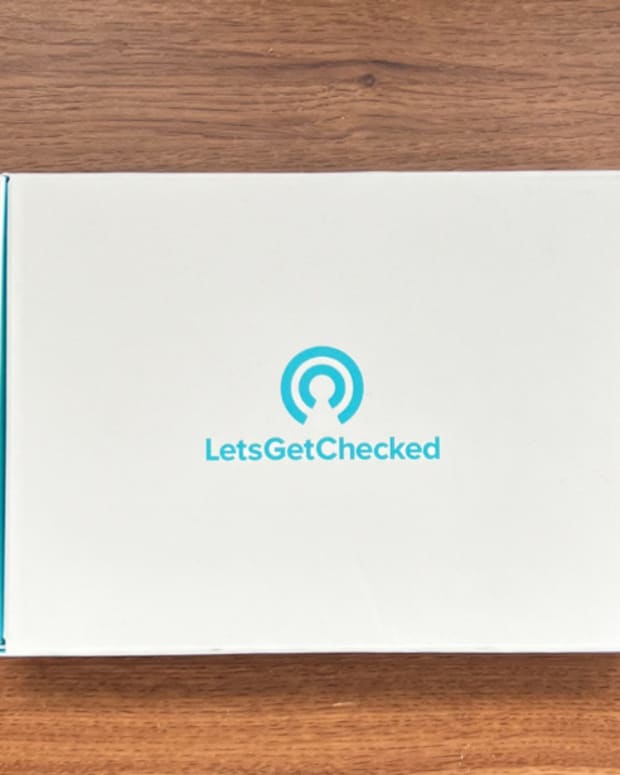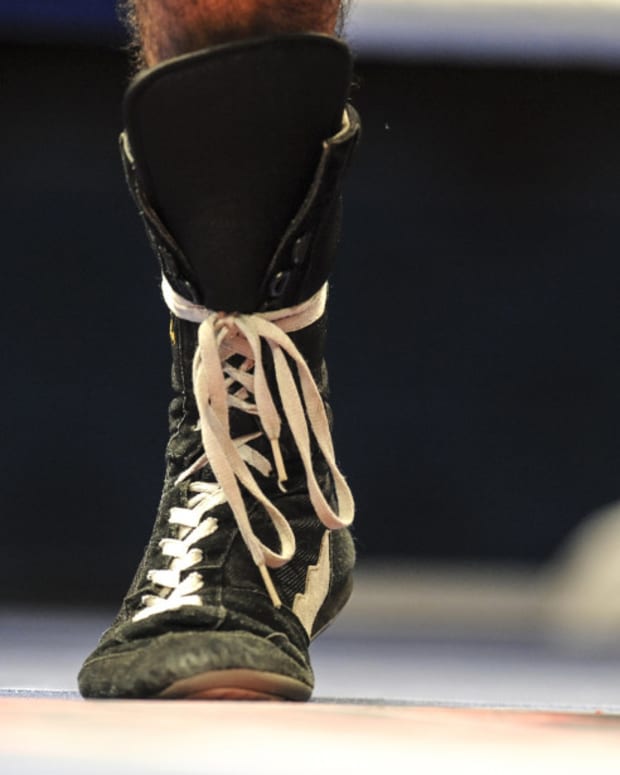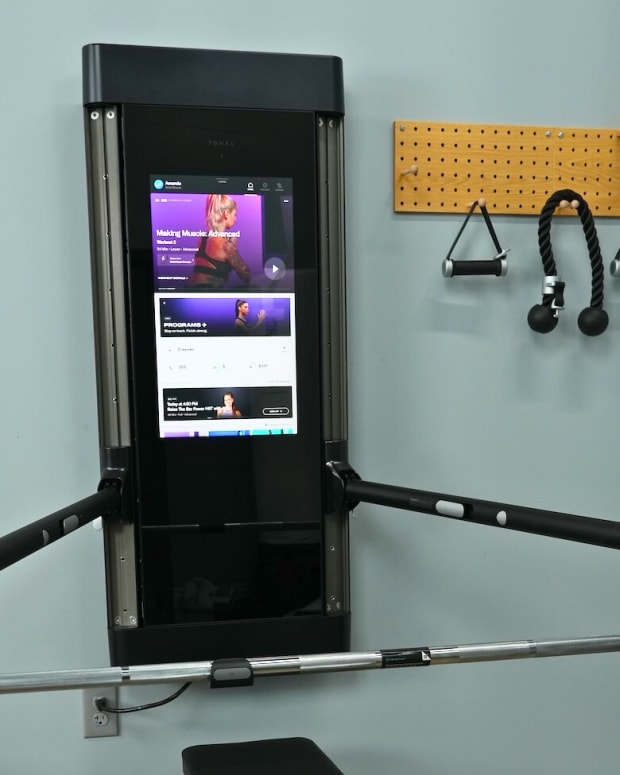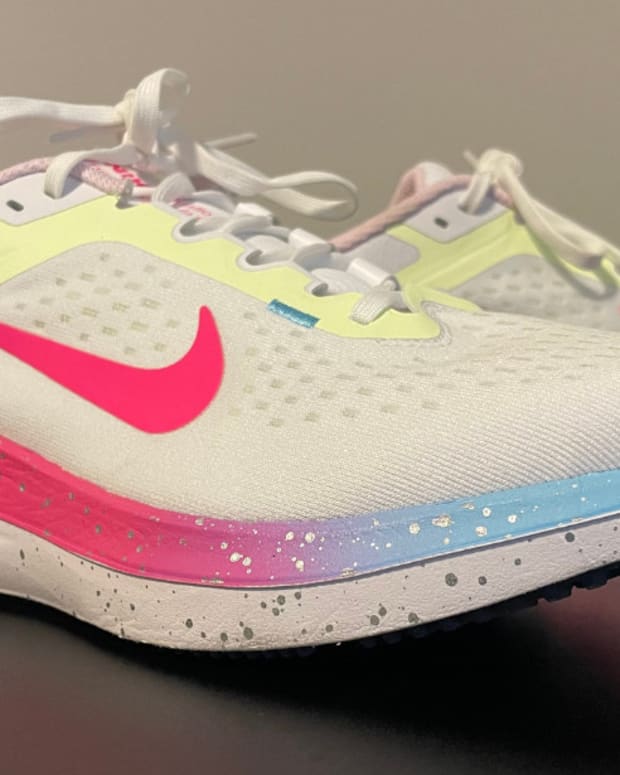The products featured in this article have been independently reviewed. When you buy something through the retail links on this page, we may earn commission at no cost to you, the reader. Sports Illustrated editorial staff are not involved in the creation of this content. Learn more here.
In late 2023, Nike expanded into the realm of producing strength equipment with the introduction of the brand’s Nike Strength line; alongside classic equipment like dumbbells, kettlebells and barbells, the brand also offers bumper plates. Bumper plates are a specific type of weightlifting plate designed to be used with a barbell.
Below, we’ll explore the benefits, key design features and pricing of the Nike bumper plates. We put these plates to the test through multiple workouts spanning a couple of weeks. Read on for what makes the Nike Strength bumper plates stand out among competitors and to determine if Nike’s bumper plates are a good choice for your commercial or home gym.
Nike Bumper Plates at a Glance
- Material: Virgin rubber or Nike Grind rubber
- Available weights: 10, 15, 25, 35 and 45 pound plates
- Full diameter: 359 millimeters to 450 millimeters
- Price: Individual plates range from $35 to $110, sets range from $675 to $2,012
What Are Nike Bumper Plates?
Bumper plates are weightlifting plates that are placed on a barbell. Unlike iron plates, bumper plates are typically made of an outer rubber material with steel inserts. This rubber material helps the plates absorb shock and reduce noise if they are dropped. Bumper plates were designed for Olympic and powerlifters, but anyone engaging in barbell strength training can make use of bumper plates.
Nike Strength offers two different bumper plate options: Nike Grind Bumper Plates (made from rubber leftover from making Nike shoes) and Nike Bumper Plates (made with virgin rubber).
Using Nike Bumper Plates
Bumper plates are ideal for Olympic-style lifts, such as a barbell snatch or clean and jerk. Since the likelihood of dropping the bar is higher in these lifts, bumper plates create a safer environment for Olympic weightlifting. These rubber-based plates can also be good for moves such as a deadlift or hip thrust, common exercises performed in bodybuilding and functional fitness. Since the weight plates will be making contact with the floor during these exercises, bumper plates are a quieter and more durable option, as they’re made to withstand hard use. Bumper plates can be used for both commercial and home gym settings. Just be sure you have the proper home gym flooring before dropping the weights on your own floor.
Related Post: The Best Weightlifting Shoes for Every Workout
How Much Do Nike Bumper Plates Cost?
Nike Bumper Plates are sold as a set. Prices range from $70 for a set of 10-pound plates to $200 for a set of 45-pound plates. The Nike Grind Bumper Plates are priced slightly higher, ranging from $76 for a 10-pound set to $220 for a 45-pound set.
You can also opt for weight sets that include other equipment to build out your gym such as a rack, bench and barbell, which range in price from $500 to $1,962.
Working Out with Nike Bumper Plates
We put the Nike bumper plates to the test by having Brandon Lunsford, a frequent weightlifter, incorporate these plates into his workouts over several weeks, testing the plates in exercises including bench, deadlift, hang cleans, thrusters and squats. Nike bumper plates have an aesthetically appealing and unique design.
The numbers on the plates (in pounds) are easy to read with lettering that is “clean and sharp and stands out clearly,” says Lunsford. “The plates glide onto the barbell with ease and stay put when in use.”
Even when dropped from overhead, Lunsford did not experience much shifting in the weights down the sleeve of the barbell. Our tester experienced difficulty grabbing and maneuvering the 45-pound plates. “The 45s are hard to hold in one hand unless you have a great grip strength or hold it by its insert,” according to Lunsford. However, Lunsford didn’t experience this with lighter plates such as the 25s, thanks to the edging.
The durability of these plates was tested over the span of two weeks using movements found in Olympic lifting, powerlifting and some CrossFit complexes, all of which included dropping the plates. Our tester found these plates had a small bounce when dropped from overhead and a noise factor he rated a 2/5 (with 1 being quietest and 5 being the loudest)—Lunsford didn’t really notice a lot of noise. These plates also scored high for durability in testing; Lunsford thinks the plates should hold up well over time but did note, “if you were to use them outdoors they may weaken over time.”
Construction and Durability of Nike Bumper Plates
Nike bumper plates are designed to fit a standard two-inch barbell. Nike says the bumper plates have been drop tested over 10,000 times to ensure quality. There are two options available (as mentioned above) with notable differences: the Nike Grind Bumper Plates and the Nike Rubber Bumper Plates.
The most noticeable difference between the two plates is the appearance. The Nike Grind Bumper Plates are made of recycled rubber, which is unused rubber from Nike footwear and other Nike manufactured products. The rubber is ground together to create an unique speckled appearance for these plates. It is important to note that according to Nike, “The Nike Rubber Bumper Plates (Grind) may yellow over time as they are exposed to ultraviolet rays such as sunlight or heat. This natural process will not affect the integrity or function of the plate.”
The Nike Rubber Bumper Plates are made of black virgin rubber, a common type of rubber used for gym equipment. The design of these plates are simple and clean: black plates with white swoosh logos and numbering.
The durability of both has been studied during manufacturing using durometer testing. A durometer test measures the hardness of products and ranks products on a scale of 1 to 100—the higher the ranking the harder the material. The higher the durometer score, the less bounce a plate will have. Having high or low bounce is important if you plan on dropping the plates—high bounce plates being dropped from overhead could cause damage to you or the barbell, though plates with more bounce tend to be less expensive. Plates with less bounce are better for frequent drops.
The Nike Grind Bumper Plates have a durometer rating of 65 +/-3, giving these plates a moderate bounce. The Nike Rubber Bumper Plates have a durometer rating of 88 +/-3, giving these plates a low bounce rating. These ratings suggest the Nike Rubber Bumper Plates have better durability with less bounce and a bit of a harder material.
Nike Bumper Plate Pros
- Ensured durability through drop testing and durometer ratings
- Users love the look of these plates with two options to choose from
- Noise when dropped is insignificant
- Minimal to no rubber smell from manufacturing
- Can be purchased as pairs of plates or full sets
Nike Bumper Plate Cons
- 10- and 15-pound plates are not designed to be dropped
- 10-pound plates in the Grind set have a smaller diameter than the rest of the plates in the set
- Weight is noted in pounds only
Who Nike Bumper Plates Are Best For
Nike bumper plates are best for those who engage in moderate to heavy barbell lifting. These weights are ideal for CrossFit, Olympic and powerlifting movements. Due to minimal bounce, these bumper plates are ideal for lifts in which the bar is dropped on the ground with velocity. I would highly recommend bumper plates for any gym setting where noise should be kept to a minimum; since bumper plates emit significantly less noise than traditional iron plates, bumper plates are ideal for lifting in a home or garage gym.
While bumper plates are designed for being dropped, they are not limited to only those types of exercises. Bumper plates can also be used for exercises where the barbell will not be touching the ground, increasing versatility of training equipment.
Who Nike Bumper Plates Will Not Work For
Nike bumper plates are not designed for lifters who measure their weight with the metric system and track using kilograms. Nike bumper plates only display pounds, which may present a challenge for certain competition settings.
Beginners may struggle using Nike bumper plates because the 10- and 15-pound plates are not designed to be dropped from overhead on their own, so if you’re not ready to stack heavier weights with 10s or 15s, you won’t be able to safely drop them. This means there is a base level of strength needed in order to use Nike bumper plates. For individuals who would need to stack multiple plates on the barbell at once, note that bumper plates do tend to be thicker than iron plates.
How We Tested
Our tester used both the 25-pound and 45-pound plates over the span of two weeks and rated these plates individually. The plates were dropped over 50 times throughout this two-week span. The tester ranked multiple components of each plate including durability, noise, bounce and ease of use.
Exercises To Do With Nike Bumper Plates
Nike bumper plates can be used for all barbell exercises and are not confined to only exercises that include dropping the bar. Bumper plates are also ideal for exercises in which a plate is used independently without a barbell. Exercises I’d recommend bumper plates for include:
- Olympic-style lifts such as the clean and jerk and snatch
- Deadlifts
- Hip thrust
- Barbell rows
- Exercises that use the plate individually, such as halos or weighted planks
Warranty and Customer Service
The warranty for Nike bumper plates differ between the plate weights and the site of use. For the 10 and 15 pound plates, there is a six month warranty that includes both commercial or home use. It is important to note these plates are not designed to be dropped without being accompanied by larger plates—doing so will void the warranty. For the 25-, 35 -and 45-pound plates, there is a three-year warranty for home use and a one-year warranty for commercial use. Please note proper flooring is needed for the warranty to be valid. This flooring includes wood or 12-millimeter-thick rubber. The Nike bumper plate warranty varies between six months to three years.
I reached out to Nike to test out the customer service. I messaged the live chat and got a response about five minutes after asking my question. For consumers who prefer to call, there is a number on the customer support website. Both live chat and calling are available 4:00 a.m. to 11:00 p.m. Pacific Time seven days a week.
Nike Bumper Plates vs. REP Fitness Bumper Plates
REP Fitness and Nike both include multiple options for bumper plates with similar price points and warranties.
REP Fitness bumper plates have a handful of features that Nike bumper plates do not. REP Fitness has the option of plates in either pounds or kilograms while Nike only offers pounds for weight measurement. REP Fitness allows users to drop all plates, while Nike discourages dropping the 10- and 15-pound plates. REP Fitness has a greater variety of options for bumper plates including black, color, competition, pinnacle, sport, animal print, hi-temp and technique.
Related Post: Save on REP Fitness With These Coupons and Discounts
Nike offers two options that include black with white text and speckled grind with black text. Although there are limited options, I find Nike bumper plates to be more aesthetically appealing. The Nike plates have the signature swoosh and if purchased as a set, the Nike coated premium barbell has the signature statement, “Just do it” across the bar. Nike also uses recycled material for the Grind plates, making Nike bumper plates an environmentally conscious choice.
The Takeaway: Are Nike Bumper Plates Right for You?
Nike bumper plates are a great option for weightlifting plates. Although bumper plates are relatively new to the Nike brand, Nike has been around since the 1960s and has a strong reputation of producing high quality products designed with athletes in mind. Since bumper plates are versatile in the sense they can be used for all barbell exercises while iron plates cannot, if it comes down to a choice of one or the other, I’d recommend bumper plates over iron.
I would recommend Nike bumper plates for moderate to advanced lifters who track their weights in pounds rather than kilograms. I would be cautious before recommending this product to beginner lifters simply because the 10 and 15 pound plates cannot be dropped, therefore creating a base level of strength needed to work with this brand’s bumper plates.
I like the look of the Nike plates with brand-specific design and believe the Nike bumper plates are a great investment for a commercial gym or as home gym equipment, especially when bought as a set including a barbell. The price for Nike bumper plates is congruent with its competitors and quality is assured through vigorous manufacturing testing and a warranty.
Prices are accurate and items in stock as of publish time.

